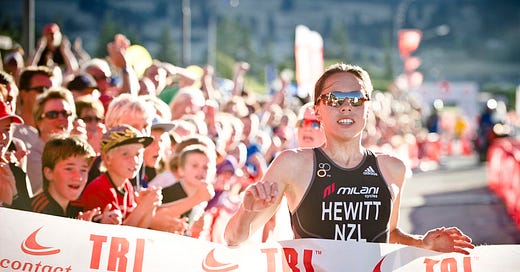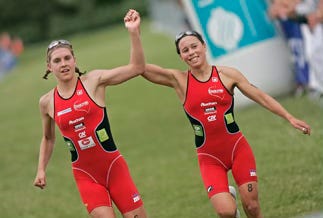We know that women are different in many respects, but what about sports? Why do women lag behind in physical prowess in most sports except those that incorporate a good deal of elegance? In triathlon, women swim, bike and run generally slower than their male counterparts. In the fifties and sixties, the performance gap between males and females in most elite sports was around 20%. With the increased female participation, this was soon reduced to approximately 10% by the eighties, but it has not shifted any further since, despite comparable coaching and training opportunities. We see that the top female triathletes can compete with the elite males, but they are unlikely to ever beat them. As we will see, there are some simple physiological explanations for that.
Body Composition
Most of the performance differences between the sexes can be explained by the smaller size and increased body fat of females compared to males. Boys and girls show similar growth until puberty. However, the boys quickly jump ahead when their bodies start producing copious amounts of the male hormone testosterone. This is the leading cause of a shift in body composition with accelerated growth of bones and supporting structures like muscles. The average young adult male is ten percent taller and outweighs the average female by 11 kg.
Usually, 12 – 18% of the weight of female endurance athletes is fat compared to 4 – 12% of their male counterparts. 23% of a woman’s body weight is muscle compared to 40% for a male. The female hormone oestrogen is responsible for depositing most of the body fat around the hips, thighs and breasts, while male fat is predominantly present in the abdominal and upper regions of the body. Under the influence of the male hormone testosterone, males usually end up with broader shoulders and narrow hips, whereas women have a wider pelvis in relation to shoulder width. The wider pelvis leads to a slight inward sloping of the thigh bone resulting in an increased inwards angle of the knee (knock knees). This anatomical variation is responsible for increased overuse injuries to the knees in female athletes who engage in weight-bearing sports. So, the main difference in body composition between males and females is that females have a smaller proportion of muscle in relation to body size, resulting in less strength.
Endurance
The capacity to consume (lungs), transport (circulation) and process (muscle) oxygen is the best single determined for success in endurance sports. As females have a smaller thorax (chest cavity), there is less lung tissue and a lower lung capacity to take up oxygen. Women compensate for this somewhat by an increased breathing rate. Women also have a smaller heart size and a lower cardiac output; therefore, the heart can pump out less blood per heartbeat than males. To maintain sufficient blood supply to the working muscle, women have to compensate with a higher heart rate by 5 – 8 beats when exercising at an equal relative exercise load compared to males. While the resting heart rate in women is higher, the maximum heart rate is similar in both sexes. The difference in heart rate in sub-maximal exercise needs to be taken into account when advising athletes on target heart rate zones using maximum heart rate as a guideline.
Absolute VO2max values are 40 – 60% higher in males. This is the total amount of oxygen expressed in litres per minute, which can be taken in during maximal exercise. The difference is reduced to 20 – 30% when corrected for body weight. A Further correction concerning fat-free weight (lean body mass) reduces the difference to 10%.
Females have approximately one litre less circulating blood than males, resulting in fewer red blood cells. The red blood cells also have a lower haemoglobin concentration in females compared to males. As oxygen is transported by the red blood cells, bonded to haemoglobin, females have a lower oxygen-carrying capacity of the circulation.
Women show similar cardiovascular adaptations to training to the same extent as men but start from a lower level.
Muscle Strength
We have already mentioned that males have a larger muscle mass than females by approximately 20%. There is a suggestion that females tend to have relatively more type 1 fibre combined with a higher activity of enzymes, which support fat oxidisation, which would make them more suitable for endurance events rather than high-intensity power activities. Not all scientists agree with this, and some have found the makeup of the muscles in males and females to be similar. The main difference in muscle mass is the increased amount and size of the muscle fibres in males.
Overall, males are 40% stronger than females. Females are relatively weaker (approximately 30 – 50% of male strength) in the upper body compared to the lower body (approximately 70% of male strength). Studies have shown that females respond equally well to strength training as males do. However, although females performing strength training gain increased strength, they put on less muscle bulk (hypertrophy). The hypertrophy, seen in males, is directly due to the male hormone testosterone.
Metabolism
It has been long thought that a woman’s relatively greater fatness can be an advantage rather than a disadvantage in endurance exercise. It was thought that women had a superior capacity to metabolise their more abundant fat stores near the end of an endurance race when glycogen stores are depleted. This would mean that, ultimately, in longer-distance races, females could outperform males.
Fortunately, or unfortunately, this theory has now been discounted by laboratory testing as well as field testing. We know that in ultra-endurance running, female performances are still significantly below that of their male counterparts, similar to performance differences observed in shorter-distance events. The lab testing has shown that males and females have an equal capacity to burn fat, a capacity that can be enhanced in both sexes by appropriate training methods. There is also no difference between storage and use of glycogen during exercise between males and females.
Flexibility
Females, in general, are more flexible than their male counterparts, which is mainly due to the effects of the female hormone oestrogen on the elasticity of joint ligaments.
Heat Tolerance
For many years, it was thought that women were unable to tolerate exercise in heat as well as men. Women’s tendency to sweat less than men has been interpreted as an inadequate response to heat stress. However, it must be considered that a 75kg male produces more metabolic heat than a 55kg female if they are running at the same relative exercise intensity (per cent VO2 max). The male athlete will have to produce more sweat to dissipate that heat.
Women have a larger ratio of body surface area to body weight, giving them an advantage in dissipating heat. Some studies have also shown women to sweat more efficiently than men. On the other hand, the capacity for sweat production by each gland is somewhat less compared to men.
In general, it has been found that females react similarly to males when exercising in hot conditions and show a similar capacity to acclimatise to heat.
Psychology
In my literature search for gender differences in psychological preparation and response to exercise, I could find little or no information. In my experience, many women seem to be tougher, more constant, more enduring, more independent, more patient, more level-headed and calmer during training and racing than their male counterparts. They also tolerate pain and exertion to a greater degree. It is evident that these characteristics make women suitable for endurance exercise. It has to be made clear that this is a generalisation comparing groups of women athletes with groups of men, and obviously, some male athletes also have superior psychological characteristics.
Conclusion
In endurance sport performance, females lag behind by 5 – 15% compared to males. Most of the difference in endurance performance is directly related to differences in body size and body composition. Another significant cause is the reduced oxygen-processing capacity of the circulation of the female. This means that if males would be handicapped by adding dead weight to equalise lean body mass to that of females, and if we removed one litre of blood at the same time, thereby equalising the oxygen-carrying capacity of the blood, it is likely that female endurance athletes would be able to compete directly with their male counterparts.
Coaching
So, what does this mean for coaching female versus male athletes? I have trained many elite and age-group females and males over the years, and I have learned that they adapt similarly to training stimuli, even if they start from a lower level, endurance and strength-wise. I have also learned that every athlete has their own unique anatomy and physiology as well as personality, and it is that combination you coach, regardless if they are male or female.
Trans Endurance Athletes
There has been recent debate about whether male-to-female trans athletes should be able to partake in women’s sports. The physiological differences between males and females explained in this article will restate this discussion as it is plain to see that it creates an unfair playing field. Even if the male athletes undergo hormonal and physical treatment, the differences, mainly created during puberty, will not be totally undone, and the residue will still give the ex-males a physical advantage. In recent times, many sports have seen sense and are not allowing female trans athletes to compete directly with females for the reasons mentioned. What if the males have aggressive hormonal and surgical treatment before they reach puberty is the next question. This is currently still hotly debated. There are other ethical issues at play besides the physiological differences. Outside of the more obvious anatomical and physiological characteristics, issues around what a female consists of are best debated by others with more experience in this area.
Further References
- Brukner & Khan's Clinical Sports Medicine by Peter Brukner and Karim Khan (2016) - This textbook covers a wide range of topics in sports medicine, including the differences between male and female athletes in terms of anatomy, physiology, and sports performance.
- Tarnopolsky, M. A. (2008). Sex differences in exercise metabolism and the role of 17-β estradiol. Medicine and Science in Sports and Exercise, 40(4), 648-654.
- Malina, R. M. (2015). Sex differences in athleticism and sports participation: an update. Sports Medicine, 45(9), 1305-1320.
Back to Table of Contents







Well said, John. Best summary I've ever read on this topic. -Joe Friel
Thanks Joe, coming from someone of your calibre is extra special 🙏